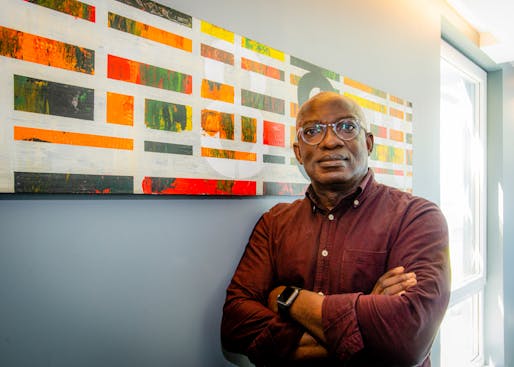Victor Body-Lawson awarded the Leadership in Housing Award from AIA New York – “Body-Lawson’s significant impact in affordable housing alone includes over 3,000 homes including supportive, workforce, transitional and senior apartments. He has also taught a generation of emerging architects as professor and critic from 1999 to today, totaling 600-plus students, bringing many of them to Ghana to share urban design ideas globally.” Image by Erik Rank
Architect, educator, artist, and public housing advocate Victor Body-Lawson has spent much of his career working towards community-driven designs that focus on integrating design, arts, and architectural education for more equitable urban solutions. Body-Lawson’s work spans New York, other neighboring cities along the East Coast, Cuba, and projects in West Africa. He advocates for equitable, urban residential projects and architects serving as their own real estate agents. His contributions to challenging public housing and propelling affordable housing initiatives have positioned him as a force in the industry. On Wednesday, June 24th, the AIA New York Chapter awarded Body-Lawson with the Leadership in Housing Award.

Home Street Residences by Body Lawson Associates
Born in Nigeria, Body-Lawson came to the United States for school and attended Catholic University of America in Washington, D.C where he pursued architecture. He received his M.Arch at Columbia University where he worked under the wing of one of the most prominent Black architects during the late 20th century, the great Max Bond who passed in 2009. Bond was the architecture department chair at the time and hired Body-Lawson to work with him at Davis Brody Bond after he graduated. In 1993 he established his firm Body Lawson Associates (BLA). Since then he’s continued to carry on the lessons and initiatives he learned while working with Bond by fostering social equity and engagement into his built works.
Body-Lawson’s work as an artist has also influenced his connectivity to the community. His acrylic paintings can be found hanging on the walls of his completed projects. In a 2020 interview with Metropolis, he shared with J. Michael Welton, “I painted for every floor and made art a part of their environment,” he says. “Every time I go there, I see smiles on people’s faces—they give me the thumbs up.”


La Peninsula development located in the South Bronx is a project in collaboration with WXY Studio. Image courtesy of Body-Lawson Associates
Other architectural outlets have described Body-Lawson’s work as “humble architecture.” However, his work is more than humble. It is responsive and empowering. His projects directly reflect his focus on creating a bridge between the built environment and the individuals living and interacting with each site. Take the Home Street Residences for example. This project has been applauded for integrating senior housing with teen community centers that foster multigenerational activity and connectivity.
Another project he’s currently working on in collaboration with WXY Architecture + Urban Design is a 740-unit mixed-use campus called La Peninsula. This project, which has recently completed its first stage will replace the inoperative Spofford Juvenile Detention Center.
Site plan for the development showing project phases. Image courtesy of WXY architecture + urban design.
Previously covered in Archinect back in November 2019 we reported, “The jail complex, formerly arranged as a series of long double-loaded corridors lined with cramped cells, is being demolished and replaced with a collection of freestanding mid-rise residential and mixed-use towers.”
Beyond his specialty, in public housing, Body-Lawson has developed a vast portfolio of mixed-use buildings and religious structures. Upon receiving the award, Body-Lawson shared in a statement, “For the past 25 years, my journey as an architect along with my colleagues has been to endeavor to empower people with architecture, especially through equity in affordable housing. So, to be acknowledged with the Leadership in Housing Award speaks volumes about our contribution to the built environment.”
Source: Architect




